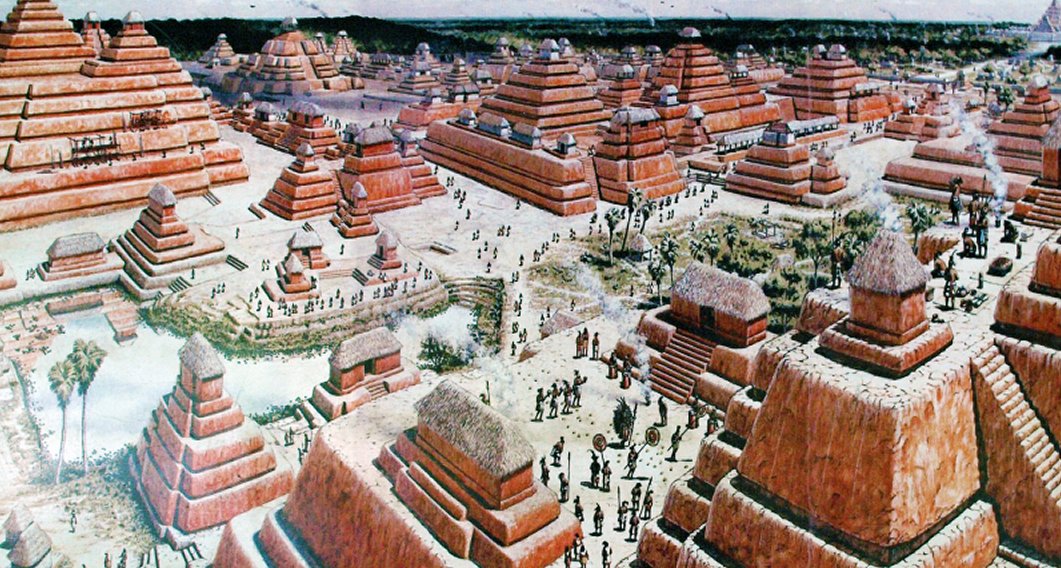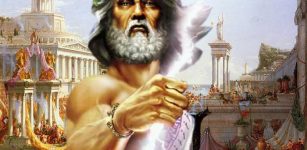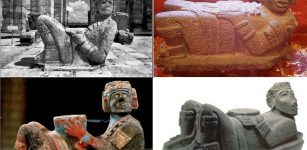Mayan Maize God And Ancient City Of El Mirador
David Tee - AncientPages.com - Deep in the heart of the Guatemalan jungle lies a little forgotten city.
It is called today El Mirador, and in its heyday, it could be seen as a vital Mayan city.
 El Mirador, Guatemala. source
El Mirador, Guatemala. source
Like other Mayan cities of that time, El Mirador was home to many Mayan gods, including the Maize god.
One of its claims to modern fame is that El Mirador is a pre-Classic Mayan city larger than many of its successors. Before it became extinct, though, the inhabitants built three pyramids within its borders.0
The largest, La Danta, used some 99 cubic feet of rock and filler material to reach its large size. It is unknown whether this was the temple of the Maize god, but since it had steps, it may have been used for human sacrifices.
The pyramids without steps were buildings that were not to be entered or touched. It is quite possible that there was a temple to the Maize god in this lost city, but records are lost, and now, nothing can be determined by archaeological excavation.
Maize God And The Young Baby Jaguar
Mayan myths are only sometimes easy to decipher as their stories change over time. The history of the Maize god can first be found in the Popol Vuh. This original myth has the Maize god being born, dying, and resurrected from the Mayan underworld.
His birth is well known and came from an illicit affair between the God N and the Wayaab. The affair was discovered when the young baby jaguar was presented to the Lady’s husband.
 Maize god, Temple 22, Copan. source
Maize god, Temple 22, Copan. source
In his anger, the Lord sent the baby away to be sacrificed. After his brothers cast the young child into a mountain, the baby jaguar was reborn as the Maize god. It is said that he sprang back into life through the seed of the maize plant.
Maize God With Jade Ornaments
It is most likely that the Maize god became so popular that the Mayan people depended a lot on maize for their dietary needs. In fact, there are over 40 types of Mayan or Mesoamerican maize agriculture forms.
This importance, even though he was not a lead god, is indicated by the inclusion of the maize god’s death and rebirth on a Mayan ruler’s sarcophagus lid. Discovered in 1949, this lid shows the Mayan ruler Pakal being born of a maize seed.
Also, the Maize god is always depicted as a young person with jade ornaments. Jade was part of the rebirth process of the Maize god. This depiction symbolized fertility, beauty, and jade.
It is possible that the Mayan people looked to the Maize god for those things that almost every member of every society wanted- long life, beauty, and wealth.
Maize God And El Mirador
One of the problems with tying the Maize god to El Mirador is that the different Mayan cities did not always worship the same gods. If they did, they often changed the name of the god to suit their beliefs at that time.
Yet, at the same time, the Mayans did recognize all their gods on a universal scale. In other words, while they did not worship the particular god by the same name, if at all, they still accepted them as a Mayan god.
Another difficulty is that it appears that the Maize god did not have his temple or house of worship. With the lack of knowledge concerning the Mayan language, pointing to a pyramid or some other abandoned Mayan structure, such as the Maize god temple, would be challenging.
With all their human sacrifices, the Mayans worshiped all their gods at the same pyramids.
Written by – David Tee AncientPages.com Staff Writer
Updated on Oct 16, 2023
Copyright © AncientPages.com All rights reserved. This material may not be published, broadcast, rewritten or redistributed in whole or part without the express written permission of AncientPages.com
More From Ancient Pages
-
 Did Human Nature’s Dark Side Help Us Spread Across The World?
Archaeology | Nov 25, 2015
Did Human Nature’s Dark Side Help Us Spread Across The World?
Archaeology | Nov 25, 2015 -
 Gods’ Creation Of Five Different Human Races – Ages Of Man On The Earth And The End Of The World
Featured Stories | Jan 26, 2018
Gods’ Creation Of Five Different Human Races – Ages Of Man On The Earth And The End Of The World
Featured Stories | Jan 26, 2018 -
 Mystery Of Prehistoric Gigantic Hill Figures Of England
Featured Stories | Sep 20, 2018
Mystery Of Prehistoric Gigantic Hill Figures Of England
Featured Stories | Sep 20, 2018 -
 Mysterious Skull Cult At Göbekli Tepe – Ancestor Worship Or Trophies Of Dead Enemies?
Archaeology | Jul 25, 2017
Mysterious Skull Cult At Göbekli Tepe – Ancestor Worship Or Trophies Of Dead Enemies?
Archaeology | Jul 25, 2017 -
 Lost Since 1362: Researchers Discover The Church Of Rungholt – A Sunken Medieval Trading Place
Archaeology | May 25, 2023
Lost Since 1362: Researchers Discover The Church Of Rungholt – A Sunken Medieval Trading Place
Archaeology | May 25, 2023 -
 Yamna Culture Started Cannabis Trade 5,000 Years Ago
Ancient History Facts | Aug 6, 2016
Yamna Culture Started Cannabis Trade 5,000 Years Ago
Ancient History Facts | Aug 6, 2016 -
 Levänluhta People Could Survive Fimbulwinter Thanks To Their Diverse Livelihoods
Archaeology | Apr 24, 2020
Levänluhta People Could Survive Fimbulwinter Thanks To Their Diverse Livelihoods
Archaeology | Apr 24, 2020 -
 ‘Viking Disease’ Hand Disorder May Come From Neanderthal Genes
Archaeology | Jun 14, 2023
‘Viking Disease’ Hand Disorder May Come From Neanderthal Genes
Archaeology | Jun 14, 2023 -
 Striking Ancient Stone Idols: The Forgotten Polovtsian Statues Of Eastern Europe
Featured Stories | Mar 8, 2014
Striking Ancient Stone Idols: The Forgotten Polovtsian Statues Of Eastern Europe
Featured Stories | Mar 8, 2014 -
 Codex Gigas – The Devil’s Bible – Ancient Secrets Of The World’s Largest Book
Artifacts | Jun 15, 2014
Codex Gigas – The Devil’s Bible – Ancient Secrets Of The World’s Largest Book
Artifacts | Jun 15, 2014 -
 Chogha Zanbil: Huge Ancient Still Existing Ziggurat Dedicated To God Inshushinak
Featured Stories | Mar 10, 2016
Chogha Zanbil: Huge Ancient Still Existing Ziggurat Dedicated To God Inshushinak
Featured Stories | Mar 10, 2016 -
 Mysterious Gigantic Jars Of Unknown Origin Discovered Worldwide
Artifacts | Dec 27, 2018
Mysterious Gigantic Jars Of Unknown Origin Discovered Worldwide
Artifacts | Dec 27, 2018 -
 Stunning Facial Reconstruction Of Saint Ludmila’s Sons Of The Czech Royal Premyslid Dynasty
Archaeology | Mar 8, 2021
Stunning Facial Reconstruction Of Saint Ludmila’s Sons Of The Czech Royal Premyslid Dynasty
Archaeology | Mar 8, 2021 -
 African Kingdom Of Axum – Ancient Ruins Of Early Churches Unearthed
Archaeology | Dec 9, 2022
African Kingdom Of Axum – Ancient Ruins Of Early Churches Unearthed
Archaeology | Dec 9, 2022 -
 First Kisses May Have Helped Spread Oral Herpes 5,000 Years Ago – Scientists Say
Archaeology | Jul 30, 2022
First Kisses May Have Helped Spread Oral Herpes 5,000 Years Ago – Scientists Say
Archaeology | Jul 30, 2022 -
 Sacred And Mysterious Lake Titicaca Still Holds Many Ancient Secrets
Ancient Mysteries | Jul 13, 2017
Sacred And Mysterious Lake Titicaca Still Holds Many Ancient Secrets
Ancient Mysteries | Jul 13, 2017 -
 10 Ancient Love Symbols
Ancient Symbols | Jan 5, 2016
10 Ancient Love Symbols
Ancient Symbols | Jan 5, 2016 -
 Image Of The Day: Chacmool – Famous Ancient Statue Of Pre-Columbian Mesoamerica
Image Of The Day | Sep 10, 2015
Image Of The Day: Chacmool – Famous Ancient Statue Of Pre-Columbian Mesoamerica
Image Of The Day | Sep 10, 2015 -
 Winged Sun Disk: One Of The Oldest And Most Important Solar And Religious Symbols
Ancient Symbols | Mar 15, 2019
Winged Sun Disk: One Of The Oldest And Most Important Solar And Religious Symbols
Ancient Symbols | Mar 15, 2019 -
 Alexander The Great’s Biblical Connection
Featured Stories | May 29, 2019
Alexander The Great’s Biblical Connection
Featured Stories | May 29, 2019
